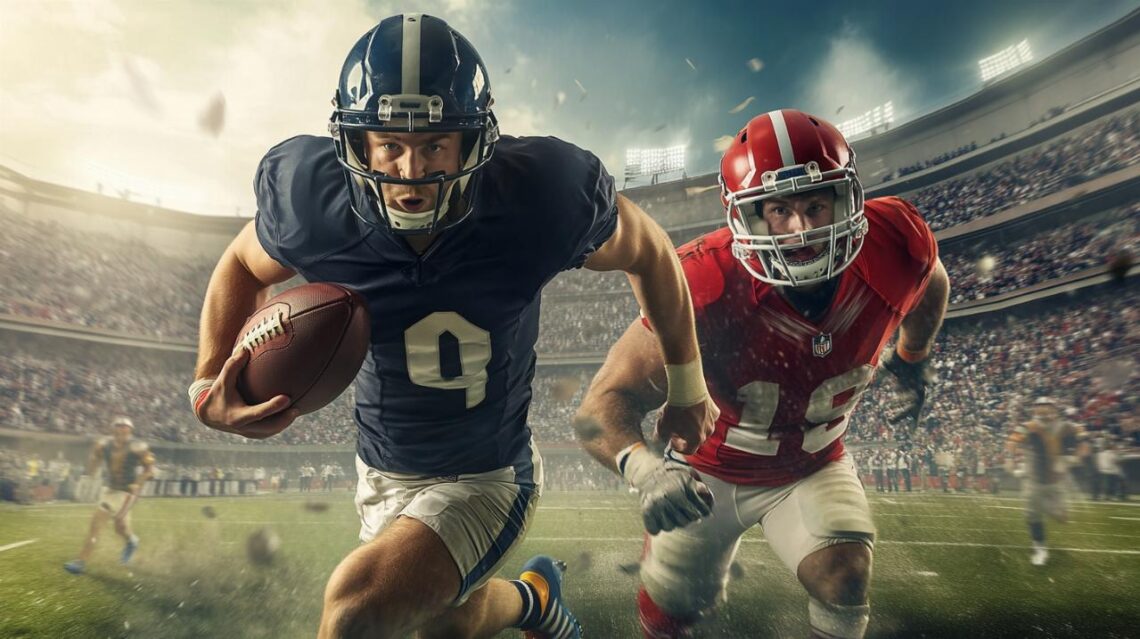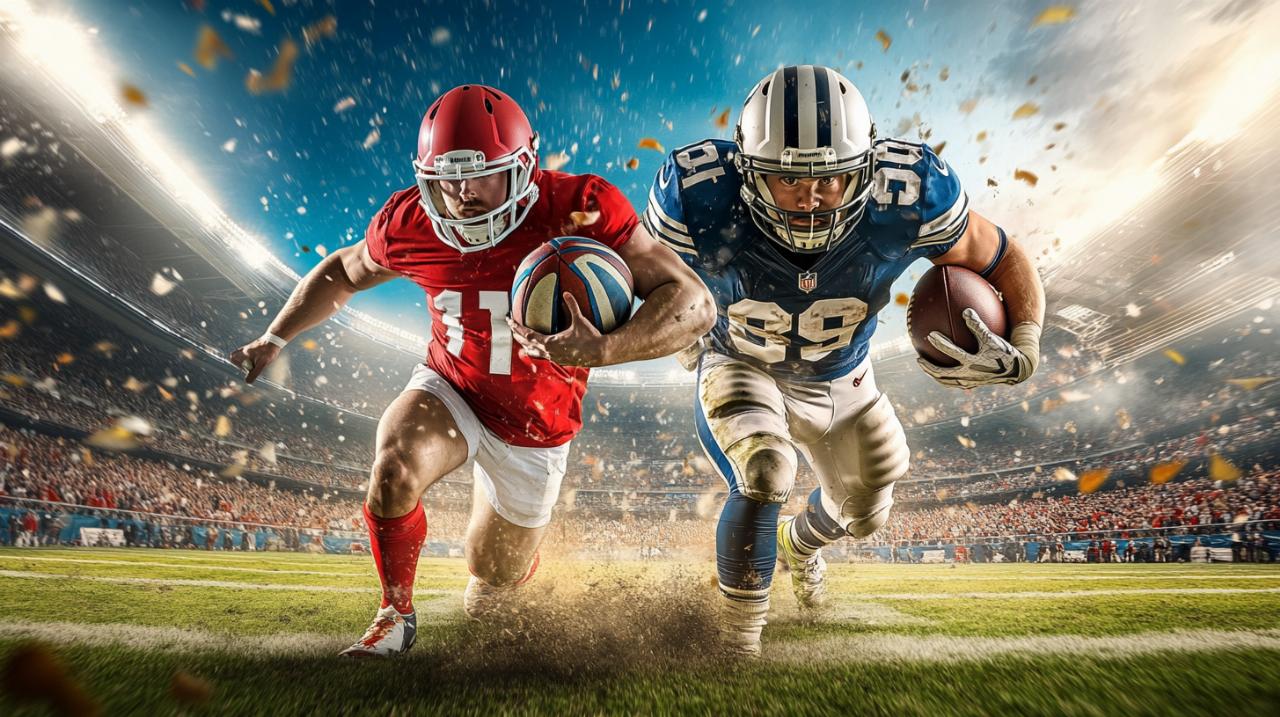
The differences between rugby and american football: how professional leagues shape two distinct sporting cultures
Across sporting arenas worldwide, two codes of football have captured the imagination of millions, each cultivating devoted followings and shaping distinctive athletic identities. Rugby and American football, though sharing certain surface-level similarities such as the oval-shaped ball and the fundamental objective of advancing into opponent territory, diverge dramatically in their rules, rhythms, and cultural expressions. These differences extend far beyond mere technicalities, reflecting broader contrasts in sporting philosophy, commercial structure, and national tradition that have evolved over more than a century of competitive play.
Fundamental Rules and Flow of Play: Stop-Start Versus Continuous Action
The most striking distinction between these two codes lies in the tempo and continuity of action once the referee's whistle sounds. This contrast fundamentally shapes how each sport unfolds, influencing everything from tactical approaches to spectator experience. Understanding this difference provides the key to appreciating why the two games feel so entirely different despite their common ancestry.
The strategic pause: american football's down system and set plays
American football operates through a carefully orchestrated sequence of discrete plays, with each team granted four attempts, known as downs, to advance the ball at least ten yards toward the opponent's end zone. This structure creates natural breaks in the action, allowing coaches to communicate intricate instructions and enabling teams to substitute entire units of players between plays. The result is a chess-like contest where strategy often trumps spontaneity, and where specialised personnel enter the field according to carefully rehearsed schemes. Television timeouts further extend these pauses, transforming a nominal sixty minutes of playing time into broadcasts that typically stretch beyond three hours. This stop-start rhythm allows for immense tactical complexity, with offensive coordinators deploying elaborate playbooks that players must memorise and execute with precision. The system also permits unlimited substitutions, meaning that a squad of fifty-three active players can be deployed strategically, with separate units dedicated exclusively to offensive, defensive, or special teams duties. Such specialisation has become a defining characteristic of the American code, creating a sport where individual moments of explosive action punctuate longer periods of anticipation and preparation.
Rugby's fluid dynamics: maintaining momentum through continuous phases
Rugby, by contrast, embraces a far more continuous style of play that keeps the clock running through most of the eighty-minute contest. The action flows through phases of possession, with the team in control attempting to maintain forward momentum whilst adhering to the requirement that passes must travel backwards or laterally. When a tackle occurs, the ball carrier must release the ball immediately, allowing teammates to contest possession at the resulting ruck or maul. This creates a dynamic ebb and flow that demands exceptional cardiovascular fitness and rapid decision-making under pressure. Unlike the American game, rugby permits only limited substitutions, typically seven or eight per match, meaning that players must be prepared to compete across the full duration with minimal respite. The result is a test of endurance as much as power, with athletes needing to balance explosive physicality with the stamina required to maintain intensity across two forty-minute halves. This continuous nature fundamentally shapes team tactics, as coaches cannot simply rotate fresh players to exploit momentary advantages. Instead, rugby rewards those sides capable of sustaining pressure through multiple phases of play, gradually wearing down opposition defences through relentless recycling of possession and intelligent exploitation of space across the expansive pitch.
Player Equipment and Physicality: Protection Philosophy and Tackling Techniques
The visual contrast between players in these two sports immediately signals their differing approaches to physical contact and player safety. Whilst both codes involve significant collisions and demand considerable courage, the philosophy underpinning protective equipment and the nature of permissible contact diverge markedly.
Armoured Athletes: The Role of Padding and Helmets in American Football
American football players take to the field encased in extensive protective gear, including hard-shell helmets with face masks, shoulder pads, hip pads, thigh pads, and various other reinforcements designed to absorb and distribute the force of high-speed collisions. This armour reflects the sport's tolerance for explosive, high-impact hits, where players may launch themselves at opponents with considerable velocity. The stop-start nature of play allows for maximum-effort collisions on every snap, with linemen crashing into one another from a stationary position and defensive backs delivering devastating hits on receivers catching passes downfield. The protective equipment has evolved into a substantial industry, with manufacturers continually developing new technologies to enhance player safety whilst maintaining mobility. However, this equipment paradoxically enables more forceful contact, as players feel emboldened to deliver blows they might otherwise avoid. The physical profiles of American football players reflect this emphasis on explosive power, with offensive linemen averaging between two hundred ninety and three hundred fifty pounds, creating human walls designed to protect quarterbacks and open running lanes. This combination of protective gear and specialised body types has created a unique sporting aesthetic, where the sheer size and power of athletes has become a defining characteristic.
Minimal Kit, Maximum Technique: Rugby's Approach to Contact and Safety
Rugby players, by contrast, compete in minimal protective equipment, typically wearing nothing more than a jersey, shorts, socks, and boots, though some opt for thin padded headguards or shoulder padding within regulatory limits. This absence of armour fundamentally changes the nature of contact, placing greater emphasis on proper tackling technique rather than pure collision force. Players must wrap their arms around opponents and bring them safely to ground, with dangerous high tackles strictly penalised. The continuous nature of play also means that athletes cannot sustain maximum-impact collisions throughout the match, necessitating a more measured approach to physical confrontation. Rugby forwards, who engage in the most intense contact through scrums and rucks, average around two hundred forty-six pounds, whilst backs typically weigh around two hundred eleven pounds, considerably lighter than their American counterparts in comparable positions. This difference reflects rugby's requirement for sustained mobility and endurance across the full pitch, rather than short bursts of maximum power. The sport's governing bodies have increasingly focused on tackle technique and concussion protocols, recognising that without protective equipment, player welfare depends entirely on skill execution and regulatory enforcement. This creates a sport where physical courage remains paramount, but where technique and controlled aggression take precedence over raw destructive force.
Ball movement and passing laws: forward passes versus lateral distribution
 Perhaps no single rule difference more profoundly shapes the strategic character of these two sports than the contrasting regulations governing how teams may advance the ball through the air. This distinction influences offensive tactics, defensive alignments, and the fundamental skill sets required of players.
Perhaps no single rule difference more profoundly shapes the strategic character of these two sports than the contrasting regulations governing how teams may advance the ball through the air. This distinction influences offensive tactics, defensive alignments, and the fundamental skill sets required of players.
The american aerial assault: how forward passing defines offensive strategy
American football's permission of forward passes revolutionised the sport in the early twentieth century, transforming it from a ground-based slugfest into a dynamic aerial contest. Quarterbacks may throw the ball forward from behind the line of scrimmage, enabling offences to gain substantial yardage in a single play by targeting receivers running precisely choreographed routes downfield. This creates spectacular moments of athleticism, as receivers leap to pluck balls from the air whilst defenders attempt to break up passes or intercept them. The forward pass has become the cornerstone of modern offensive strategy, with elite quarterbacks commanding enormous salaries for their ability to read defensive coverages and deliver accurate throws under pressure. This emphasis on passing has also generated complex defensive schemes, with coordinators deploying various zone and man-to-man coverages designed to confuse quarterbacks and limit passing options. The ability to gain significant ground through a single forward pass fundamentally alters tactical considerations, as teams trailing late in games can mount rapid comebacks by targeting the end zone through the air. This dimension adds considerable drama and unpredictability, contributing to American football's status as compelling sporting theatre and helping to explain the enormous commercial appeal that has made the Super Bowl one of the world's most-watched sporting events.
Backwards progress: rugby's lateral movement and running game philosophy
Rugby's prohibition on forward passes creates an entirely different strategic landscape, requiring teams to advance primarily through running with the ball and supporting runners ready to receive lateral or backward passes. This restriction generates a more collective style of play, as individual brilliance must be supported by teammates running angles and providing passing options. Attacks develop through multiple phases, with players recycling possession at breakdowns and seeking to manipulate defensive alignments through patient build-up play. The inability to throw forward means that territory must be gained through sustained effort rather than single explosive plays, rewarding teams with superior fitness and cohesion. Kicks become crucial tactical weapons, as they represent the only legal method of advancing the ball forward through the air, though possession is relinquished when doing so. This creates tactical dilemmas around when to risk kicking for territory versus maintaining possession through carries and lateral distribution. The backwards-passing requirement also emphasises spatial awareness and decision-making, as players must constantly scan the field for support runners whilst evading defenders. This generates a flowing, improvisational quality that contrasts sharply with American football's set-piece precision. Rugby's approach creates a sport where collective endeavour and sustained pressure ultimately determine outcomes, reflecting perhaps a different sporting philosophy that values endurance and teamwork over individual moments of spectacular execution.
Professional league structures and cultural impact: how governance shapes identity
Beyond the technical differences in rules and gameplay, rugby and American football have developed through contrasting organisational structures and commercial models that reflect their distinct cultural contexts and historical trajectories. These differences in professional governance have profound implications for how each sport is experienced, consumed, and understood within their respective societies.
The nfl model: commercial powerhouse and american sporting theatre
The National Football League has evolved into perhaps the most commercially successful sports enterprise in the world, wielding enormous cultural influence within the United States and generating staggering revenues through media rights and sponsorship deals. The league's broadcasting contract covering the period from two thousand twenty-three to two thousand thirty-three is estimated to be worth between one hundred five and one hundred ten billion dollars, reflecting the sport's unparalleled ability to command television audiences and advertising expenditure. A thirty-second commercial during the Super Bowl costs approximately seven million euros, testament to the event's status as a national spectacle that transcends sport itself. This commercial might has shaped American football's presentation, with frequent stoppages accommodating advertisements and creating a viewing experience designed for broadcast consumption. The NFL operates as a tightly controlled entity with centralised governance, franchise systems, and salary caps designed to maintain competitive balance whilst maximising collective revenue. This model has created extraordinary wealth for team owners and star players alike, whilst also generating criticism regarding player welfare, particularly concerning concussion protocols and the physical toll of the sport. Nevertheless, American football's cultural dominance within the United States remains unchallenged, functioning as a shared national ritual that brings communities together on autumn weekends and culminates in the Super Bowl's extraordinary spectacle each February.
Rugby's global tapestry: union and league traditions across nations
Rugby presents a more fragmented yet globally distributed professional landscape, reflecting its origins in English public schools during the eighteen twenties and subsequent spread throughout the British Empire. The sport split in the late nineteenth century into Rugby Union and Rugby League, creating two distinct codes with differing rules and cultural associations that persist today. Rugby Union, which features fifteen players per side, maintained amateur principles until the mid-nineteen nineties, when the sport finally embraced professionalism. This relatively recent commercial development means that rugby's professional structures remain less centralised than American football's model, with multiple competing leagues and tournaments operating across different continents. The Rugby World Cup, held every four years, represents the sport's pinnacle, with the French edition in two thousand twenty-three expected to generate a net profit of sixty-eight million euros for rugby development within France, a figure dwarfed by American football's annual revenues yet significant for the sport's ongoing growth. Rugby's global distribution creates fascinating cultural variations, with the sport holding profound importance in nations such as New Zealand, South Africa, Wales, and England, where it functions as a vehicle for national identity and community pride. Educational institutions such as AMOS, which offers sport management courses at campuses including London among other European cities, prepare students for careers navigating this complex sporting landscape. Rugby's professional evolution continues to grapple with balancing commercial imperatives against traditional values, creating ongoing debates about the sport's future direction and identity in an increasingly commercialised sporting world.

